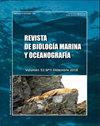Proteínas transmembranales de organismos tipo rickettsia (OTR) en animales acuáticos: Factores de adherencia, invasión e infección
IF 0.5
4区 生物学
Q4 MARINE & FRESHWATER BIOLOGY
引用次数: 1
Abstract
Besides participating in the transport of essential compounds and as recipients of phages, transmembrane proteins of rickettsia-like organisms (RLO), play an important role in the infection process of commercially important organisms such as fish, mollusk and crustaceans. Recently a new classification of RLO which divides them into four groups was reported: ancestral, typhus, the spotted fever and transitional. To date, only the typhus (TG) and spotted fever (SFG) groups have been reported as pathogenic of marine organisms. The outer membrane surface of the TG group has antigens type 0, 1, 2, 4, 5 (Sca0, Sca1, Sca2, Sca4, Sca5). Sca0 are also known as outer membrane proteins A (OmpA) and Sca5 as outer membrane proteins B (OmpB). Other outer membrane proteins such as enzymes called translocase (Tlc) have been detected, including translocase 1, 4 and 5 (Tlc1, Tlc4 and Tlc5). All these proteins (except for Sca0) have been detected in the SFG group. These proteins vary in features and functions. However, the information of RLO affecting marine organisms is not as common as that of terrestrial mammals. An analysis of the state of the art on the study of transmembrane proteins of RLO in marine organisms is performed in this review; additionally, the hypothetical infection mechanism of these RLO is inferred by using this information together with that reported of RLO affecting terrestrial organisms.水生动物中立克次体型生物的跨膜蛋白:粘附、入侵和感染的因素
立克次体样生物(RLO)的跨膜蛋白除了参与必需化合物的运输和作为噬菌体的受体外,还在鱼类、软体动物和甲壳类等具有重要商业价值的生物的感染过程中发挥重要作用。最近报道了一种新的RLO分类,将其分为四组:祖先型,斑疹伤寒,斑疹热和过渡性。迄今为止,只有斑疹伤寒(TG)和斑疹热(SFG)组被报告为海洋生物的致病性。TG组外膜表面有0、1、2、4、5型抗原(Sca0、Sca1、Sca2、Sca4、Sca5)。Sca0也被称为外膜蛋白A (OmpA), Sca5被称为外膜蛋白B (OmpB)。其他外膜蛋白如转座酶(Tlc)已被检测到,包括转座酶1、4和5 (Tlc1、Tlc4和Tlc5)。除sc0蛋白外,其余蛋白均在SFG组中检测到。这些蛋白质在特征和功能上各不相同。然而,RLO影响海洋生物的信息并不像陆地哺乳动物那样普遍。本文对海洋生物中RLO跨膜蛋白的研究现状进行了综述;此外,这些RLO的假设感染机制是通过将这些信息与报道的影响陆生生物的RLO一起推断出来的。
本文章由计算机程序翻译,如有差异,请以英文原文为准。
求助全文
约1分钟内获得全文
求助全文
来源期刊
CiteScore
0.70
自引率
0.00%
发文量
41
审稿时长
12 months
期刊介绍:
Publicar desde una perspectiva científica, artículos originales, decididos por un proceso de revisión por pares, invitando a expertos de reconocido prestigio en el área. Los trabajos publicados se caracterizarán por su solidez teórica-metodológica, actualidad y relevancia para las ciencias marinas.
Se reciben trabajos inéditos derivados de la investigación científica realizada en ambientes marinos y estuarios, en formato de Revisión, Artículos, Notas Científicas, y Obituarios en las siguientes disciplinas::
Biología-Ecología marina
Oceanografía física, química y biológica
Contaminación marina
Geología marina
Sistemática, Faunística y Biogeografía Marina
Manejo Costero
Acuicultura marina
Pesquería marina.

 求助内容:
求助内容: 应助结果提醒方式:
应助结果提醒方式:


